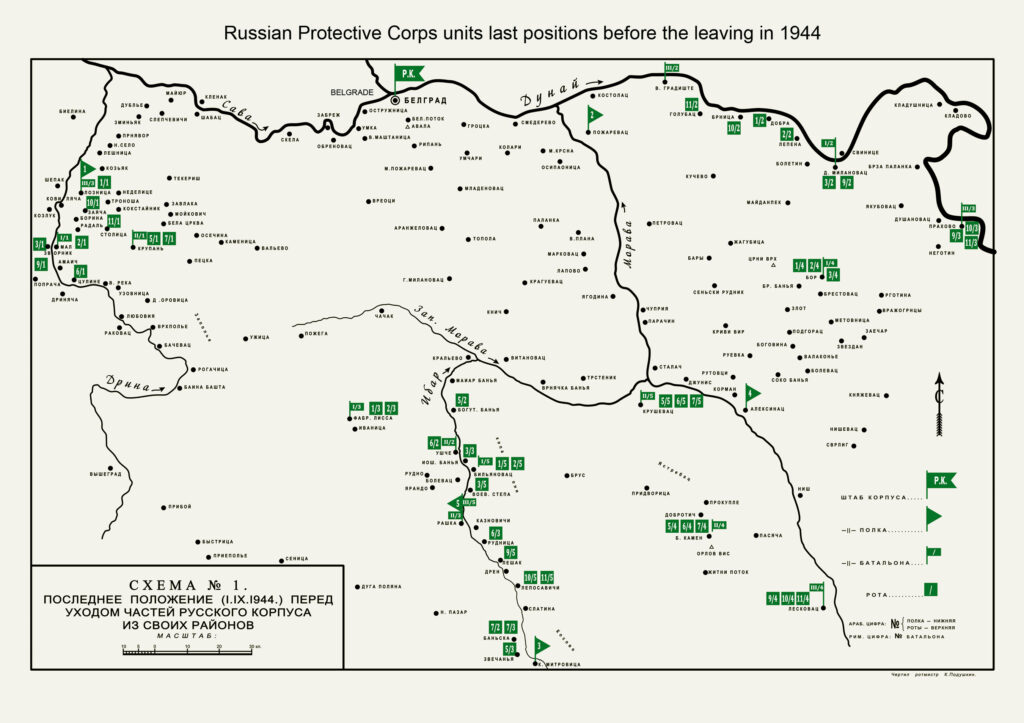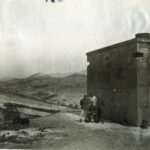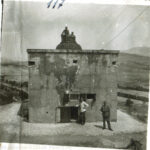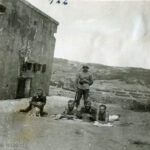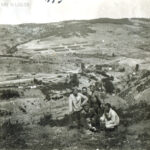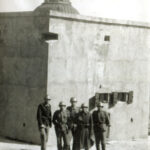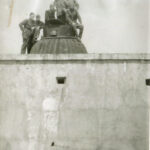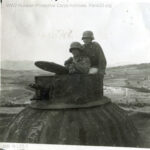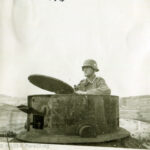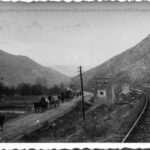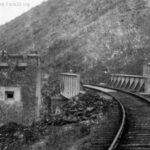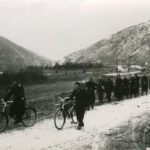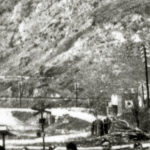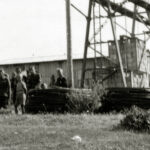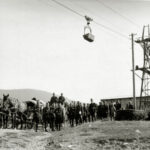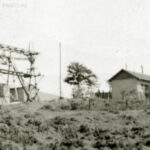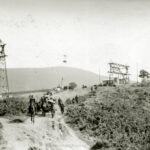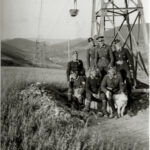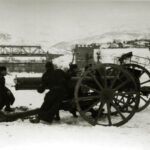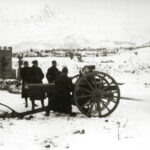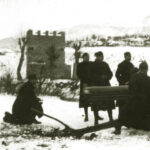In this section we post available information and our own photo archives about barracks, headquarters, bunkers, railway stations and bridges and other buildings and fortifications during the Second World War in Yugoslavia, where ranks of the Russian Security Corps were located.
An extract on the location of bunkers, military units guarding them and the nearest regimental and battalion headquarters.
Bor mine, bunkers N6, 8, N14 and?
As of January 1944, there were 14 bunkers located to protect the town and mine along the heights that surrounded them. Mentioned in memories N8 and N14 (guarded the side entrance to the mine)
Bunker N 6 valley near the Bor mine.
One of the strongest and most durable bunkers, made of the concrete (or cement?) with iron windows and a metal turret (anti-airplane). Guard looked and shot through the entire valley, the railroad and the bridge. A series of photographs believed to have been taken in 1943 by Peter Gattenberger and placed in his personal photo album.
- Valley and mountains, N L03-10
- Bunker N6 in the Bor mine valley, MB L03-08.
- Valley and barracks in the distance, L03-12
- German and Russian barracks, railway and bridge, L03-9
- View of the bunker from the southwest, N L03-03
- On the dome of the N6 bunker, embrasures, L03-5
- Armored turret on the bunker dome, L03-7
- Peter Gattenberger in a helmet with binoculars, L03-6
L03-6. Peter Gattenberger, owner of the photo album ( “L”), after WW2, a member of the Society of Russian Veterans of the First World War in San Francisco (USA) and long-term head of the museum.
Bunkers 128-148 and No. 178-179 in the area Ušča – Banje – Banska station – Kraljevo – Raška railway.
Ushcha district on August 18, 1944:
III battalion of the 3rd regiment (General Petrovsky, headquarters Ushcha) until August 18, 1944.
II battalion 2nd regiment after August 18, 1944, headquarters in Ushcha:
5th company (II battalion 2nd regiment) – headquarters in Bogutovačka Banje and bunkers 128-137,
6th company – headquarters in Ushcha and bunkers 137-148,
7th company – Banska station and bunkers 178-179 of the Kraljevo-Raska railway.
On the night of September 7-8, 1944, the Red partisans crossed the Ibar River and attacked the bunkers of the 6th company (II battalion, 2nd regiment) with the result of the fighting:
Bunker No. 138 successfully repelled the attack,
No. 139 – captured by partisans.
Bunker No. 140 also successfully repelled the attack.
Bunkers Nos. 141 and 142 were burned with incendiary bombs and their garrisons withdrew to No. 143.
Changes in structure 15 September 1944: Colonel Baltsar’s 5th Training Company arrived at the II Battalion and was renamed the 5th Company of the 2nd Regiment, and the old 5th Company merged with the 6th Company. The headquarters of the 5th company became in Ushcha, and the 6th – in Bogutovačka Banya.
Bunker No. 171 – Drain
On August 3-4, 1944, near this bunker, the 7th company of the 5th regiment (on the march) fought with the Reds. The 7th company repulsed all attacks on August 3-5. On August 24 they attacked again.
Bunker N 174 Valley of the Ibra River and Ushcha region.
Battles on the Ibra River from August 3 to 5, 1944. The bunker was garrisoned by 7 companies of the 3rd regiment: Corporal Maslakovets Nikolai, Corporal Zhuravsky Arkady, Chief Rifleman Ilya Boltenkov and Rifleman Georgiy Cherevchin under the command of Lieutenant Shevchenko. For three days, the garrison heroically repelled attacks by the Reds of up to 500 people using heavy weapons. After the Reds offered to surrender, Lieutenant Shevchenko refused. The Reds used bombing fire to destroy bunker N 174, and the defenders were killed.
Bunkers No. 176-184 at the Leposavichi area
On August 3, 1944, bunkers No. 176-184 in the Leposavichi sector were surrounded by significant Red forces. At the same time, the partisans attack bunkers in the area of the village of Rudnitsa (on August 4, communication with the bunkers to the south was lost). Some of the bunkers are surrounded and under fire from the Reds.
Garrisons of D. Milanovac, Boletin and Dobra (north-eastern Serbia).
In the second half of the summer of 1944, due to the strengthening of communist detachments and the transfer from Montenegro and Bosnia, the garrisons of D. Milanovets, Boletin and Dobra strengthened their positions – they built bunkers, wire fences, minefields, etc.
Garrison D Milanovets, including the headquarters of the 1st battalion (2nd regiment), the 3rd and 9th companies and a platoon of heavy weapons fought until October 8, 1944. On October 9, the commander of this battalion, Major Sevrin, was killed and the commander of the 1st battalion took command of the detachment of the 1st battalion. 1st company Hauptmann Kalinin. The detachment left D. Milanovac and moved to Smederevo-Grotska with the goal of escaping the Soviet encirclement. On October 17, 1944, the detachment fought near the village of Beleg, and on the 18th it was finally destroyed near Avala, and Ltn. Gamburtsev was killed, and the rest of the command staff was taken prisoner.
- Transition from Post N20 to Rudnitsa (?Germans) B41
- Road from Rahove to K. Mitrovica, bunkers near bridges (N B41 fragment)
- Voivode Stepa, BB11
- Voivode Stepa, BB11d
- Mini bunker, guard post, under the tower (N B42d)
- The famous air line from Zvecan to Rahove, B42
- The same small bunker and houses, B43d
- “Travel from Rahove to Kosovo Mitrovica” B43
- Ground position socket type (?) B44
- Bridge and bunker near Jošanička Banja resort, B53
- Artillery firing, B54
- Bunker in Jošanička Banja from the other side, B54d

